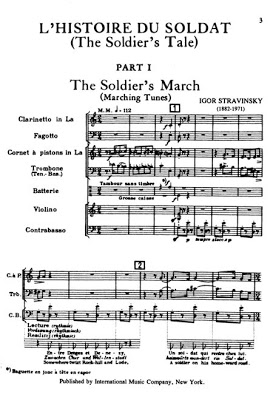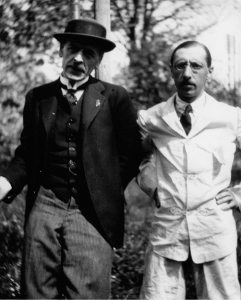Streamed concert available April 3 will feature Stravinsky’s “Soldier’s Tale”
By Peter Alexander April 2 at 1 p.m.
The past year has been the year of the chamber orchestra.
To respect the need for safe distancing between players, orchestras including the Boulder Philharmonic have presented entire programs of music written, or arranged, for reduced orchestra or chamber ensembles. Each of the Philharmonic’s 2020-21 performances has been recorded and streamed for ticket purchasers to access from the safety of their homes—as most orchestras have done.
That trend continues with the Phil’s next concert, but with a twist. The one piece on the program for Saturday (April 3, available from 7:30 p.m.), Stravinsky’s theater piece L’Histoire du soldat (The soldier’s tale), is ideal for performance during a pandemic—because it was in fact written during the last global pandemic, the Spanish Flu of 1918–19.
Stravinsky sat out World War I in Switzerland. As the war was coming to an end, the production of large-scale works, such as his previous ballets The Firebird, Petrushka and The Rite of Spring, was no longer possible. Instead, Stravinsky thought of creating a theater piece for a small group of musicians and actors that could be toured to Swiss villages.
Stravinsky and the Swiss writer C.F. Ramuz collaborated to write L’Histoire du soldat, based on a Russian folk tale and written for seven players (violin, string bass, clarinet, bassoon, trumpet, trombone and percussion), three actors and a dancer—ideal numbers for safely distanced performances. In the end, the flu defeated Stravinsky’s plan for a tour, but L’Histoire was premiered in Lausanne, Switzerland, in 1918. The music has retained a place in the chamber orchestra repertoire, and the score is important as a bellwether of the transition from the massive musical works of the pre-war period to the neo-classicism of the late 19-teens and ‘20s.
The folktale that provided the plot is one that Stravinsky knew from Russia, but it is found in many different cultures: A lonely soldier engages in a contest with the devil. This is a well known story, from legends of Paganini selling his soul for unnatural fiddle skills, to Blues musicians being in league with the devil, to the Charlie Daniels Band’s “The Devil Went Down to Georgia.”
In the story worked up by Stravinsky and Ramuz, the soldier trades his fiddle—representing his soul—to the devil for knowledge that will make him wealthy. The soldier prospers and marries a princess, but the devil returns and triumphs in the end.
“I think it’s a confusing story to follow,” Michael Butterman, conductor of the Boulder Phil, says. “It helps to have some frame of reference. I’m going to give a brief outline of what’s happening, so that people understand that the devil keeps coming back in different guises and disguises.”
The basic moral of the story, Butterman says, is that the soldier gets lots of stuff, but stuff doesn’t make him happy. “It’s all nothing without the fiddle—that’s your soul,” Butterman says. This is essentially the message of a passage from the Gospel According to Mark, “What shall it profit a man, if he shall gain the whole world, and lose his own soul?” Butterman suggests.
Although 20th-century modernist in style, the music is easily grasped by listeners. “We have marches,” Butterman explains. “Although they are not totally regular in their march rhythm, they still feel like left, right, left, right. You have three dances that are stylized, but clearly identifiable. And there’s chorales that sound like chorales.”
The dances are a tango, a waltz, and one titled “Ragtime”—but, Butterman observes, “it’s not going to remind anybody of Scott Joplin.” Stravinsky had never heard American jazz performed, although he had some printed copies. He used the rhythms as he saw them on the page and listeners will likely recognize the syncopations.
“Stravinsky sees everything through his own unique prism,” Butterman says. “What’s interesting about the piece to me is that it sounds less complex that it appears on the page. It’s a very complicated piece to put together and to conduct, just technically speaking. Much of the music does not line up at all with the meter that he’s [notated].”
Those are complications for the performers, but not necessarily for the listeners. “There’s enough familiar both in terms of the story and in terms of the musical forms that you know where to glom onto it” Butterman says. “The music is accessible, it’s not highly dissonant, it’s downright tuneful, quite clever, and always given to you in digestible chunks.”
The performance is presented in collaboration with the CU Department of Theater and Dance and the Boulder Ballet. The performance, which has already been recorded, was staged by Bud Coleman, department chair. Theater students fill the roles of four actors—a narrator, the soldier, and two actors to portray the devil. Boulder Ballet has provided the dancer and choreography.
# # # # #
Members of the Boulder Philharmonic Orchestra
Michael Butterman, conductor
Staged by Bud Coleman with actors from the CU Dept. of Theater and Danc
Dance from the Boulder Ballet
Stravinsky: L’Histoire du soldat (The Soldier’s Tale)
Available at 7:30 p.m. Saturday, April 3 (through April 17)
Pre-concert discussion at 7 p.m.



